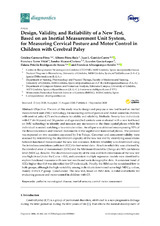Mostrar el registro sencillo del ítem
Design, Validity, and Reliability of a New Test, Based on an Inertial Measurement Unit System, for Measuring Cervical Posture and Motor Control in Children with Cerebral Palsy
| dc.contributor.author | Carmona-Pérez, Cristina | |
| dc.contributor.author | Pérez-Ruiz, Alberto | |
| dc.contributor.author | Garrido Castro, Juan Luis | |
| dc.contributor.author | Torres Vidal, Francisco | |
| dc.contributor.author | Alcaraz-Clariana, Sandra | |
| dc.contributor.author | García-Luque, Lourdes | |
| dc.contributor.author | Rodrigues-de-Souza, Daiana Priscila | |
| dc.contributor.author | Alburquerque Sendín, Francisco | |
| dc.date.accessioned | 2020-09-09T07:27:33Z | |
| dc.date.available | 2020-09-09T07:27:33Z | |
| dc.date.issued | 2020 | |
| dc.identifier.uri | http://hdl.handle.net/10396/20425 | |
| dc.description.abstract | Objective: The aim of this study was to design and propose a new test based on inertial measurement unit (IMU) technology, for measuring cervical posture and motor control in children with cerebral palsy (CP) and to evaluate its validity and reliability. Methods: Twenty-four individuals with CP (4–14 years) and 24 gender- and age-matched controls were evaluated with a new test based on IMU technology to identify and measure any movement in the three spatial planes while the individual is seated watching a two-minute video. An ellipse was obtained encompassing 95% of the flexion/extension and rotation movements in the sagittal and transversal planes. The protocol was repeated on two occasions separated by 3 to 5 days. Construct and concurrent validity were assessed by determining the discriminant capacity of the new test and by identifying associations between functional measures and the new test outcomes. Relative reliability was determined using the intraclass correlation coefficient (ICC) for test–retest data. Absolute reliability was obtained by the standard error of measurement (SEM) and the Minimum Detectable Change at a 90% confidence level (MDC90). Results: The discriminant capacity of the area and both dimensions of the new test was high (Area Under the Curve ≈ 0.8), and consistent multiple regression models were identified to explain functional measures with new test results and sociodemographic data. A consistent trend of ICCs higher than 0.8 was identified for CP individuals. Finally, the SEM can be considered low in both groups, although the high variability among individuals determined some high MDC90 values, mainly in the CP group. Conclusions: The new test, based on IMU data, is valid and reliable for evaluating posture and motor control in children with CP. | es_ES |
| dc.format.mimetype | application/pdf | es_ES |
| dc.language.iso | eng | es_ES |
| dc.publisher | MDPI | es_ES |
| dc.rights | https://creativecommons.org/licenses/by/4.0/ | es_ES |
| dc.source | Diagnostics 10(9), 661 (2020) | es_ES |
| dc.subject | Pediatric neurological disease | es_ES |
| dc.subject | Inertial sensors | es_ES |
| dc.subject | Control motor assessment | es_ES |
| dc.title | Design, Validity, and Reliability of a New Test, Based on an Inertial Measurement Unit System, for Measuring Cervical Posture and Motor Control in Children with Cerebral Palsy | es_ES |
| dc.type | info:eu-repo/semantics/article | es_ES |
| dc.relation.publisherversion | https://doi.org/10.3390/diagnostics10090661 | es_ES |
| dc.relation.projectID | Junta de Andalucía. PI-0324-2017 | es_ES |
| dc.relation.projectID | Junta de Andalucía. PIN-0079-2016 | es_ES |
| dc.relation.projectID | Instituto de Salud Carlos III. DTS18/00046 | es_ES |
| dc.rights.accessRights | info:eu-repo/semantics/openAccess | es_ES |

